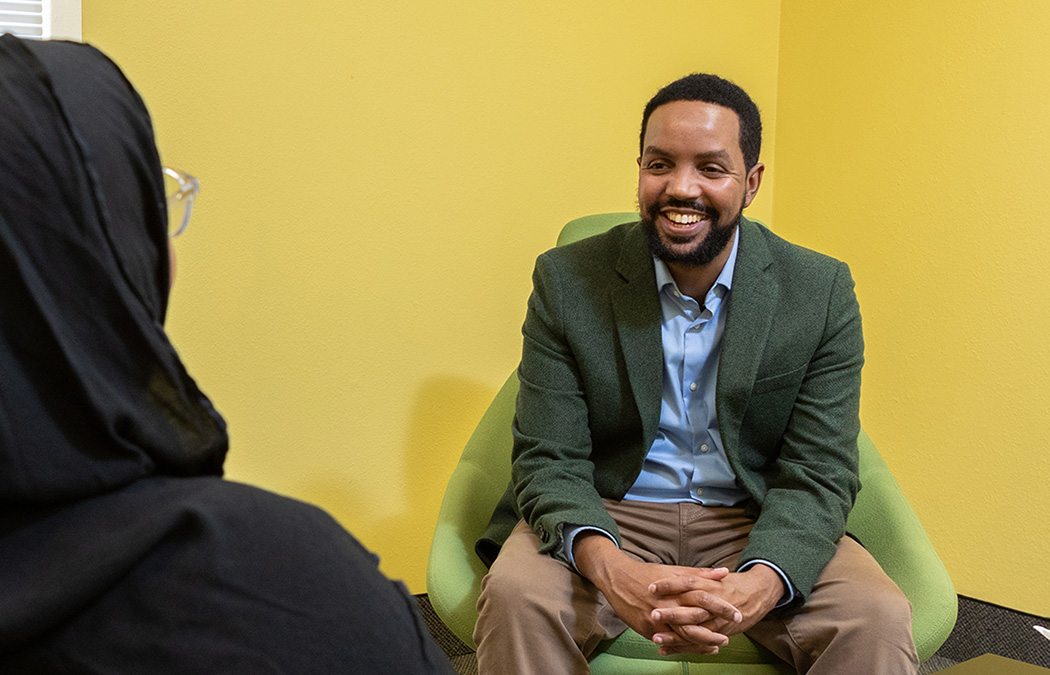Eliminating barriers to mental health services
Ali Aden M’20, C’20 says you don’t go into counseling for the money.
“If you are there for the money, you’re in the wrong field. We’re in it to help people,” he said.
It was this desire to help people that brought him to Saint Mary’s.
Aden had been working in the human service field in case management and employment counseling. As clients were coming in with depression and other mental health issues, he knew he didn’t have the skills to address those issues, so he decided to pursue a master’s degree in Counseling and Psychology from Saint Mary’s. It helped that his wife, Lul Nur M’11, was already a graduate of the program and a licensed therapist.
It was their continued desire to help people that led them to move from the Twin Cities to St. Cloud and open Bridge Healing Center, a culturally specific mental health service, in June 2022.
The couple, both from Somalia (with Nur raised in Egypt before coming to the U.S.), saw many East Africans traveling all the way from St. Cloud to the Twin Cities to obtain mental health services. Although a large Somali population lives in St. Cloud, Aden says there was nothing available for them.
In Bridge’s relatively short history, it has grown from a staff of two to six full-time staff members and another four contracted therapists. Although they see primarily East Africans and Africans, Aden said they serve other diverse populations.
“We see an increased need for mental health services across the board, across financial statuses, race. Those migrating from other countries are no exception,” he said. “It’s important to meet people where they are and have a culturally appropriate understanding and the staff who can relate to them and in whom they can see themselves.
That opens a lot of doors.” Aden said more mental health providers of color, particularly men, are desperately needed in Minnesota. It is also beneficial when they can speak multiple languages.
“We have staff who speak multiple languages: Somali, English, and Arabic,” he said. “That’s important. That eliminates the barrier of trusting another person, the interpreter, and it creates a stronger relationship with your provider because you connect with them. You don’t have to explain where you came from, your customs.”
He said one barrier often begins with navigating how to find the services needed, particularly if English isn’t your primary Language.
In addition to mental health services, they’ve also added addiction treatment services.
“Kudos to Saint Mary’s,” he said. “I was doing mental health counseling and they told me I could add on (a certificate) in addiction studies, and I jumped in and didn’t look back. It saved me time and money. I had a really good experience that had a lot of impact on me and my career,” he said. “The field is changing. They used to look at mental health and addiction studies as two different things.
Now the feeling is that they go hand in hand; you can’t treat one without the other. Most of our staff are mental health therapists who also have licenses in addiction. We are able to treat both and also in a cultural lens.”
Aden explains that right now, they have the ability to house six East African men battling addiction, but it is their goal to expand and eventually offer lodging for women with addictions as well.
“You could be coming from a war-torn country, using substances to cope with the trauma you have had in the past,” he said. “They need resources. We saw that need. That’s why we went into the field, to help folks. We hope to make a longstanding impact by being an organization that’s living its mission and vision, providing help to everyone who needs the help in an ethically appropriate way.”
The hours are long and the need is great. Aden explains that with addiction services, he and his team spend about six hours a day, four days a week, with their clients. “You get to know them,” he said. “And you see the change from the day they come in to the day they graduate, physically and mentally. You see their healing from past trauma. You are so involved and engaged, no two days are the same, and there are always challenges and the need is tremendous, but to see them leave the program in a much healthier space than when they came in is worth it.
